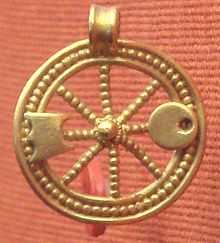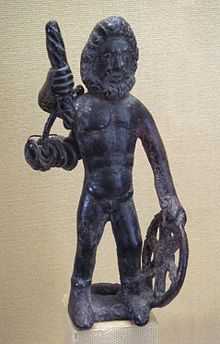Catubodua
Catubodua (Proto-Celtic: Katubodwā, "battle crow") is the name of a Gaulish goddess inferred from a single inscription in Haute Savoie, eastern France that actually reads ATHVBODVAE AVG SERVILIA TERENTIA S L M [1] plus the debatable assumptions that an initial C has been lost and that ATEBODVAE, ATEBODVVS and ATEBODVI [2] in 3 other inscriptions in modern Austria and Slovenia are unrelated.
She appears to be identical to the Irish goddess Badb Catha. Nicole Jufer and Thierry Luginbühl provisionally link Catubodua with other apparently martial goddesses attested elsewhere, such as Boudina, Bodua, and Boudiga, whose names share roots meaning either 'fighting' or 'victory'.[3] She would therefore be comparable to the Roman Victoria and the Greek goddess Nike and possibly the Nordic goddess Sigyn.
A related Roman legend?
A story of the Roman wars against the Gauls of the 4th century BC, recorded by Livy, Aulus Gellius and Dionysius of Halicarnassus, may preserve a reference to her. A Roman soldier, Marcus Valerius, accepted a challenge to single combat with a Gaulish champion. When the fight began, a crow landed on Valerius's helmet and began to attack the Gaul, who, terrified by this divine intervention, was easily beaten. Valerius adopted the cognomen "Corvus" (crow), and as Marcus Valerius Corvus went on to be a famous general and politician of the Roman Republic.[4]
Name and etymology
In the Gaulish language, the name Catubodua is believed to mean battle-crow.[5][6]
Etymological lexical forms reconstructed in the University of Wales' Proto-Celtic lexicon, suggest that the name is likely to be ultimately derived from the Proto-Celtic *Katu-bodwā, a word that could be interpreted as ‘battle-fighting’.[7] Nonetheless it is this second element *bodwā which appears to be the Proto-Celtic root of the later form of the name Badhbh. The masculine form *bodwos ('fighting') developed in Gaelic into Bodb.
References
- ↑
- ↑
- ↑ Jufer, N. and T. Luginbühl (2001). Répertoire des dieux gaulois. Paris, Editions Errance.
- ↑ Titus Livius. Periochae. Book 7:10.
- ↑ Georges Dottin (1918) La Langue Gauloise, Grammaire, Textes et Glossaire. Paris Librairie C. Klincksieck. p. 235 and 244
- ↑ arbre-celtique
- ↑ Proto-Celtic—English lexicon. University of Wales Centre for Advanced Welsh and Celtic Studies. (See also this page for background and disclaimers.)

